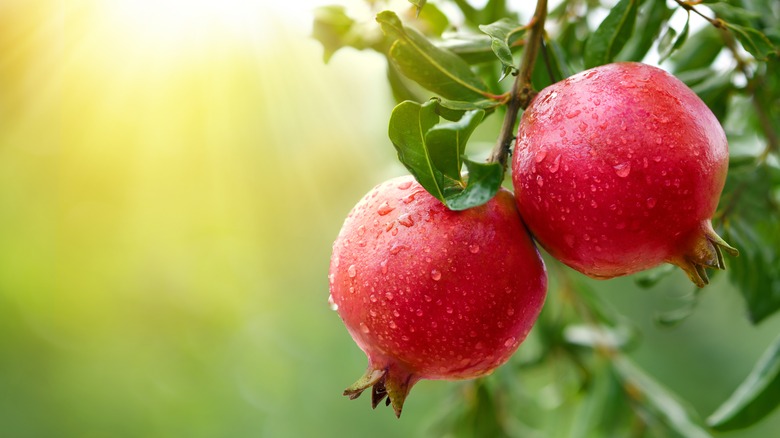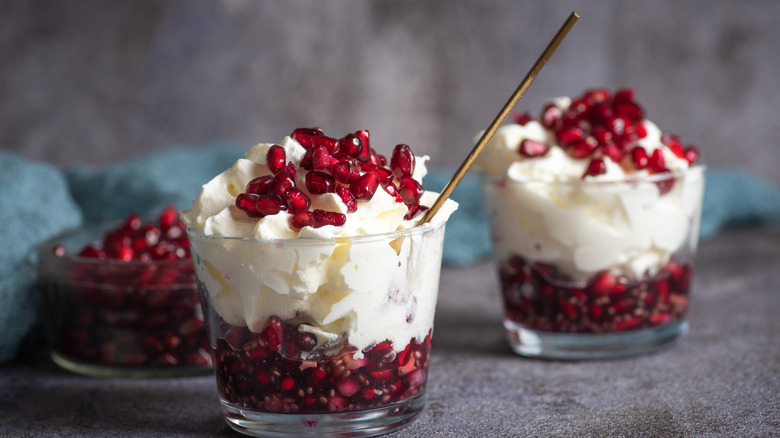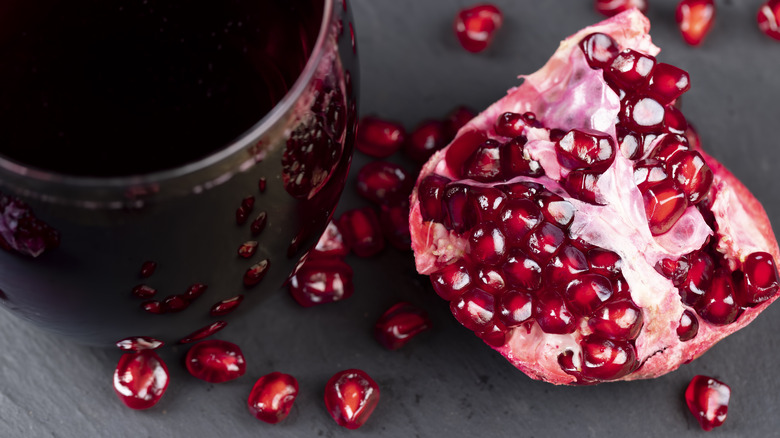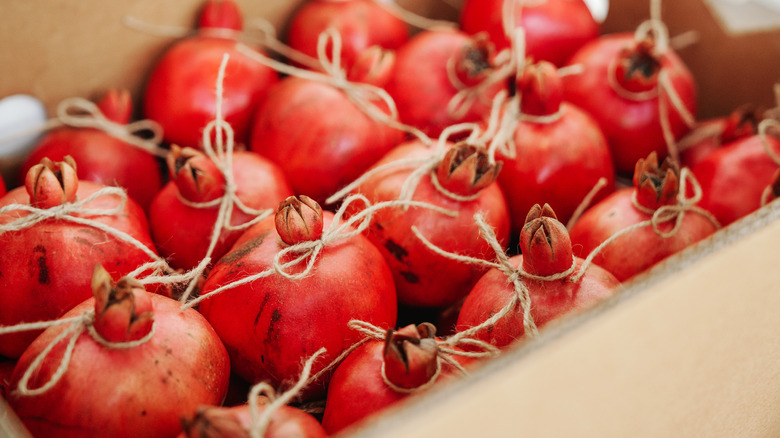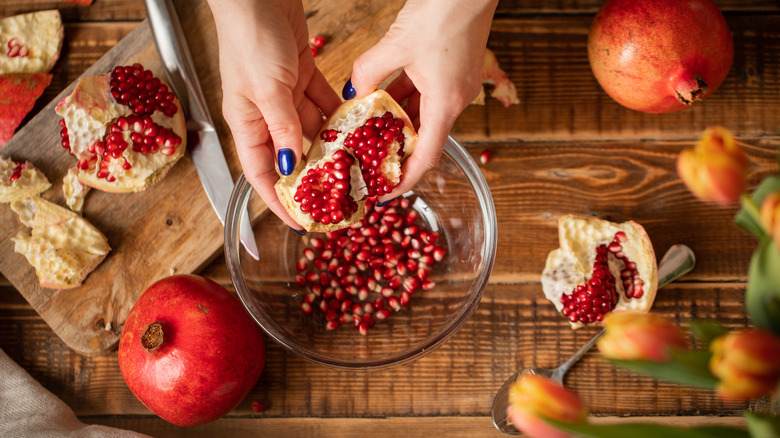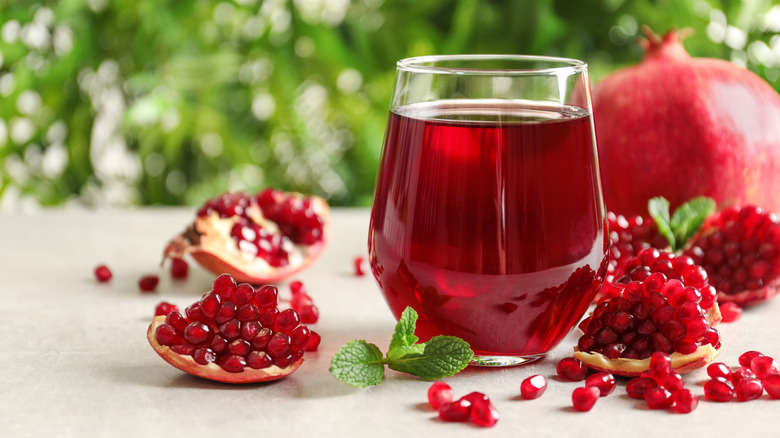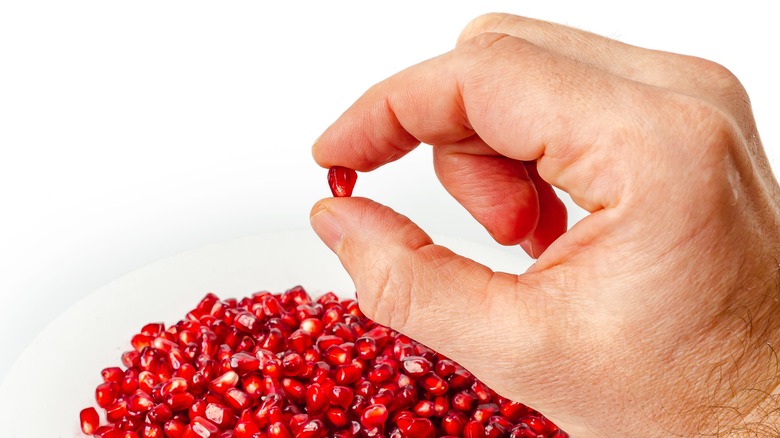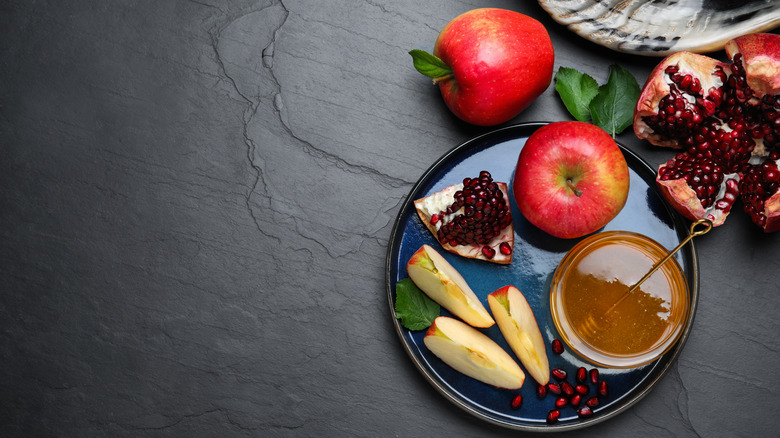False Facts About Pomegranates You Thought Were True
Like a jewel nestled within a crown of leaves, the pomegranate is a testament to nature's blend of the bizarre and beautiful. Described by Jane Grigson as "no more than a closet of juicy seeds," this ruby-red fruit captivates poets and artists alike. Opening a ripe pomegranate is like discovering hidden treasures, but you almost always expect a struggle and a messy splash of dark red juice.
Beyond its physical allure, the pomegranate carries deep-seated symbols across cultures and religions. It represents fertility and embodies sacred commandments, with its 613 seeds said to reflect the mitzvot in Jewish tradition. From the ancient texts of Persia to the tapestries of medieval Europe, this fruit has been revered, often symbolizing prosperity and the hope of fruitful progeny.
Yet, amidst all the admiration, questions and misconceptions arise. Do pomegranates truly possess life-giving properties? Do they thrive only in the Middle East? And what about the idea that all parts of this fruit are edible — can you really munch on the skin and white membrane without a second thought? We aim to peel back the layers of myths surrounding pomegranates, squeeze out the truth, and discard the pulp of fiction, providing a fresh perspective on this ancient fruit, seed by seed.
False: Pomegranates are too messy and difficult to eat
You've probably seen juicy pomegranates on a shelf and thought, "That looks delicious, but nope, I'm not dealing with that mess." Of course, the image of dark red juice splattering everywhere while wrestling to open a pomegranate isn't exactly appealing. But the good news is that this messy and difficult-to-eat reputation is simply a myth that deters people from enjoying this nutritious fruit.
So, why do people think pomegranates are messy? The culprits are the arils, the shiny, jewel-like seeds encased in white, spongy membranes just beneath the pomegranate's red skin. Separating these seeds from the membranes can be tedious, and the juice can easily stain your clothes and fingers at the slightest mishap. This perception of pomegranates being challenging to eat has led many people to avoid them altogether.
But there are several easy tricks to enjoying this fruit without the mess. If you've been cutting pomegranates wrong your whole life, one method sure to change your mind is to cut the fruit in half, score it lightly into wedges, and then submerge them in a bowl of water. This way, the arils will sink to the bottom while the membranes float, making them easy to skim and discard. Another quick way to deseed pomegranates without splatter is to tap the fruit's skin firmly with a spoon over a bowl. These simple and efficient methods debunk the myth that pomegranates are a hassle to eat.
False: They're only suitable for desserts
While pomegranates' sweet-tart flavor naturally complements a wide variety of desserts, relegating the fruit to the treat category is a major misconception. This belief persists because pomegranates, with their juicy, ruby-red arils, regularly feature in so many sweet dishes — from garnishing cakes to sweetening fruit salads — where they add a pop of color and a burst of sweet, tangy flavor.
But this is just scratching the surface of the fruit's culinary potential. Pomegranates can elevate a range of recipes beyond desserts. Their distinct blend of sweetness with a tangy kick makes them a perfect ingredient for enhancing dishes. As a staple in Middle Eastern cuisine, pomegranate molasses — a concentrated form of pomegranate juice — is a game-changer in the kitchen. It serves as a sweetener and a complex flavor enhancer for glazing meats and adding depth to vegetables.
For instance, marinating chicken in pomegranate molasses before grilling will infuse it with a sweet, salty, and umami richness. When combined with olive oil and vinegar, pomegranate molasses likewise can give a salad dressing the perfect balance of sweet and sour. So, the truth? Pomegranates are not a one-trick pony destined only for the dessert table; they're incredibly versatile ingredients that enhance many dishes, proving indispensable in a well-rounded kitchen. The next time you cook, consider using pomegranates to add a flavorful twist to your meal.
False: Pomegranates are nothing special nutritionally
Many people lump most fruits into a single nutritional basket, assuming they boast similar benefits. Sadly, this belief ignores the unique nutritional profiles of each type of fruit, especially the pomegranate. Contrary to this common myth, the sweet-tart fruit packs a powerful nutritional punch. It's a rich source of vitamins C and K, folate, potassium, and fiber, outshining many other fruits in specific nutrient levels. For example, a single pomegranate can provide up to 40% of the recommended daily vitamin C intake, essential for immune function and skin health, and significantly more than what you'd get from an apple.
But the real game-changer lies in the fruit's high antioxidant content. Pomegranates are bursting with polyphenols, antioxidants that can be vital for fighting oxidative stress in the body. They're particularly rich in punicalagin, a compound rare in many other fruits that is linked with reduced inflammation risk and improved cardiovascular health. What's more, pomegranates' antioxidant capacity exceeds that found in red wine and green tea, both widely considered to be great sources of antioxidants.
So, dismissing pomegranates as nutritionally average misses the mark. Their unique blend of vitamins, minerals, and antioxidants, especially those polyphenols, provides health benefits that few other fruits can rival. Pomegranates are, indeed, nutritional powerhouses deserving of a special spot in our daily diets.
False: All pomegranates have red seeds and juice
Ever cracked open a pomegranate, expecting a burst of dark red seeds, only to be surprised by something different? Many people believe that all pomegranates have red seeds and juice, a belief that likely stems from the predominance of the familiar "Wonderful" variety in the American market, known for its ruby-red seeds and vibrant juice. This particular variety makes up almost 95% of the U.S. pomegranate market so it's no surprise many of us only think that pomegranates are red.
The truth is far more colorful. Pomegranates boast a remarkable diversity in seed and juice colors across their many varieties. Beyond the familiar Wonderful variety, almost 13 types of edible pomegranates challenge the red-only myth. For example, the Parfianka pomegranate may have familiar red skin, but could surprise you with sweet pink seeds that hint at a wine-like flavor. Originating from Russia, the Golden Globe variety, which stands out thanks to its yellowish hue and soft arils, offers a uniquely sweet taste experience that diverges from the typical pomegranate flavor profile.
This spectrum of colors and flavors highlights the rich diversity of pomegranates across the globe. While the Wonderful variety is a popular choice for many, expanding our palates to include different types of this fruit can enrich our culinary experiences.
False: They come exclusively from the Middle East
The Middle East boasts a rich history with pomegranates, but the diea that all pomegranates come exclusively from this part of the world is not entirely true. This myth persists in part because of the rich history of the pomegranate in Persian culture, and given the fruit's ancient ties and frequent mentions in other Middle Eastern literature and art, it isn't surprising that it's become such a widely enrenched belief. Sadly, this narrow view overlooks the pomegranate's impressive journey across multiple continents.
While the sweet-tart fruit likely got its start in what is now Iran, its cultivation soon spread far and wide. By the time of the ancient Egyptians, the pomegranates were already popular in their land, where the fruit symbolized prosperity and ambition. The fruit's cultivation spread swiftly across the Mediterranean, reaching the hands of the Greeks and Romans, who cherished it for its taste, mythological associations, and supposed health benefits. It also became a symbol of abundance, beauty, and faith for the ancient Jewish people.
The story doesn't end there. Pomegranates ventured beyond the Mediterranean and found their way to Arabia, Afghanistan, India, and even China, eventually earning the nickname "Chinese apple" due to their popularity there. This expansive growth pattern underscores the pomegranate's adaptability and the global appreciation of its beauty and flavor. The truth is that pomegranates are far from Middle Eastern exclusives. Their rich history of cultivation spans continents and cultures, making them a truly global fruit.
False: They can cure countless health issues
This widespread myth is a blend of truth and exaggeration. Of course, pomegranates are naturally bursting with rich antioxidants and other anti-inflammatory compounds, making it easy to see why people might think this fruit is a magic bullet for all manner of health problems. But while pomegranates boast beneficial compounds, the leap from supportive dietary components to a cure-all is a stretch.
Modern research, though optimistic about the fruit's potential benefits, consistently highlights the need for more evidence and research into the properties of this fruit. So far, studies haven't conclusively proven that pomegranates can prevent or treat heart disease, high blood pressure, cancer, diabetes, or other health problems. This means that, at least currently, the idea that they can magically fix countless health issues is more myth than fact.
Still, pomegranates are a nutritious addition to a balanced diet and likely offer certain health benefits primarily related to their antioxidant content. However, they're not a substitute for medical treatment. Like many aspects of nutrition, the effects of pomegranates on health are part of a larger, more complex picture involving overall diet and lifestyle. Consuming them can contribute to well-being, but they're surely not the cure-all that some claim they are.
False: Pomegranates are too expensive
We get that this belief might have you skip these ruby-red fruits on your next grocery run. It's understandable why many think this fruit will take a serious hit on their wallet. Pomegranates are seasonal and flourish only in specific climates. This limited availability, coupled with the high demand for this fruit, often drives up prices and can make pomegranates seem like a luxury rather than a staple. The twist? The perception of pomegranates as prohibitively expensive is not all that accurate.
Sure, their prices might be higher outside their peak season, but this is more a reflection of the costs of off-season farming and importation. However, during their harvest season, which typically peaks in the fall depending on your region, the market may be flooded with fresh pomegranates. This abundance naturally drives prices down, making them much more affordable. To put this into perspective, consider this insight from one cost-conscious Redditor who pointed out that pomegranates can actually be quite cost-effective. They noted that even when not on sale, you can get about 10 ounces of seeds for $2.99, which amounts to 3-4 servings. During sales, prices can drop to $0.99 each or even less.
When you break it down by serving or ounce, especially compared to other red fruits, pomegranates offer decent value for money. So, when you hear someone say pomegranates are too expensive, remember — with great timing and savvy shopping, you can enjoy these delicious, nutritious fruits without breaking the bank.
False: The best pomegranates are packed with more seeds
We've all seen those bursting pomegranates overflowing with juicy red seeds in ads. It's tempting to think a pomegranate packed with seeds is the ultimate prize, as this is a widely-held belief reinforced by cultural practices and symbolic meanings attached to the seed count in pomegranates. For instance, in Jewish tradition, pomegranates are eaten on Rosh Hashana, with a prayer that one's merits increase to match the seeds of the pomegranate, reflecting a desire for abundance and goodness.
Also, some Jewish intellectual have referenced a pomegranate's 613 seeds, paralleling the number of mitzvot (commandments) in Judaism, adding a layer of spiritual significance to the fruit's seed count. This has perhaps led some to romanticize the idea that more seeds not only represent more merits but could also imply a superior fruit in terms of taste or nutritional value. But the number of seeds in a pomegranate doesn't directly correlate with its quality, flavor, or nutritional content.
The number of seeds in a single pomegranate range broadly between 200 and 1,400 and have no impact on the fruit's nutritional value or its taste. The quality of a pomegranate is instead determined by factors such as its ripeness, which then influence its color and juiciness rather than sheer number of seeds. So, when choosing a pomegranate, don't be swayed by the myth of seed count — focus instead on the fruit's firmness and vibrant color, as these are better indicators of the best pomegranate.
False: Pomegranates are just for juicing
This myth has been floating around for far too long. Many people believe that the only way to enjoy pomegranate seeds is by squeezing them into a glass. This misconception stems in part from the fruit's notorious reputation for being messy to eat, as well as the fact that its juice is widely available and often celebrated for its health benefits. Unfortunately, this perspective severely limits the incredible versatility of pomegranates.
The juicy truth is that pomegranates can be a culinary powerhouse far beyond mere juicing, adding a fantastic sweet-tart pop and unique texture to a variety of dishes — ranging from salads to cooked meals and even baked goods. Imagine scattering these glistening jewels over a roasted Brussels sprouts dish or mixing them into a wild rice salad for an unexpected crunch. Or, consider how they could elevate the flavor profile of a moist, orange-scented cake, where the arils can also bring additional texture.
Once you start experimenting with pomegranates in your cooking and baking or even using them as a garnish to add a burst of color and flavor to your dishes, you'll realize their potential is nearly limitless. The next time you reach for a pomegranate, think beyond the juice. You might just find yourself rushing back to the store for more, eager to explore all the delicious possibilities this fruit has to offer.
False: Eating pomegranate seeds can be toxic
This myth appears to stem from a mix-up with other fruits where consuming certain parts can be harmful. This confusion might also arise from the slightly bitter taste of the pomegranate's white pith, a flavor experience that might be mistakenly associated with toxicity.
When it comes to pomegranates, the arils or seeds are safe to eat and are actually a treasure trove of nutrition. Encased in juicy, ruby-red sacs, these crunchy seeds are a powerhouse of antioxidants, packed with vitamins, and are a great source of dietary fiber. Just half a cup of this fruit's seeds provides a generous 3.48 grams of dietary fiber, making pomegranates an excellent addition to a healthy diet.
Similarly, pomegranate juice extracted from the seeds is a widely cherished and oftentimes healthful drink revered for its antioxidant properties. While it's true that the pomegranate's leathery skin and the white, spongy membrane housing the arils aren't intended for consumption — being bitter and not particularly pleasant to chew upon — they're not poisonous unless you somehow eat them in very large amounts. As you crack open this fruit today, you can certainly feel free to enjoy the seeds without worry.
False: Pomegranates are a new superfood trend
It's easy to think of pomegranates as a recent superfood phenomenon, especially with all the modern hype around their health benefits. This perception is bolstered by the recent surge of pomegranates' popularity in health and wellness circles, where the fruit is often touted for its antioxidant properties and potential to fight various diseases. But labeling pomegranates as a new trend is completely misplaced.
Pomegranates are far from a modern-day discovery. In fact, their significance spans back over 4,000 years and is deeply rooted in the historical and cultural fabric of many societies. Pomegranates are among the oldest known domesticated fruits, with a rich history that is documented through ancient texts, artifacts, and even religious scriptures. For instance, pomegranates are mentioned numerous times in the Hebrew scriptures, and many scholars contend that the original fruit forbidden in the Bible to Adam and Eve in the Garden of Eden was, in fact, a pomegranate rather than an apple.
Pomegranates have been revered for their unique flavor and health benefits well before the term "superfood" was ever coined. Their enduring presence through millennia speaks volumes about their intrinsic value to human health and culture. So, whenever you hear someone refer to pomegranates as a new thing, know that these vibrant fruits have been boosting human health long before it became trendy to do so.
